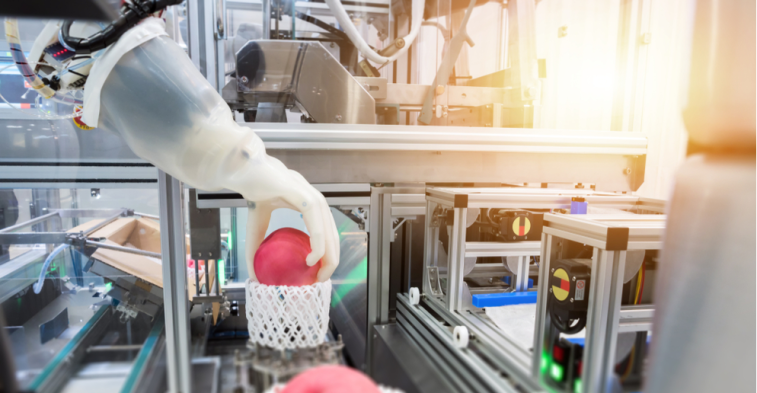5 Innovations in Manufacturing Processes and Their Effect on the Bottom Line
Manufacturing is a rapidly evolving industry. With a broad spectrum of sectors depending on manufacturing, modern facilities are often quick to adopt new technology that improves on their existing processes.
The rise of automation, artificial intelligence (AI) and data have created a wave of digital transformation. As manufacturing grows and becomes increasingly competitive, capitalizing on Industry 4.0 innovations can determine whether or not a company will succeed.
Here’s a look at five of these innovations and how they affect the bottom line.
1. Cobots
Robots aren’t new in the manufacturing industry. But as automation has grown, new approaches and technologies have emerged that can take its benefits further. Collaborative robots, or cobots, are one of the most significant of these upgrades to factory automation.
In a 2021 study, 44.9% of surveyed businesses said that robots are an integral part of their operations. Of those companies, 34.9% had adopted cobots. Cobots have slowly become more popular as manufacturers have realized the limits of traditional automation. Other robotic solutions are expensive and inflexible, making it difficult to scale, but not cobots.
Since cobots work alongside humans instead of replacing them, they typically automate fewer processes at once. Consequently, they’re often more affordable than traditional automation and easier to implement. Manufacturers can then automate one process at a time, slowly scaling up to meet demand or new challenges.
This incremental approach to automation removes the high upfront costs and disruptions of traditional automation. As a result, cobots enable manufacturers, especially smaller businesses, to scale up and down with ease. These companies can then enjoy quicker, higher ROIs.
2. IoT Sensors
Another growing innovation in manufacturing is the implementation of internet of things (IoT) sensors. While these technologies aren’t a manufacturing-specific phenomenon, they hold considerable potential in this sector. Perhaps their most popular and impressive use case is predictive maintenance.
Predictive maintenance improves on traditional maintenance schedules by avoiding both breakdowns and unnecessary repairs. According to a Deloitte report, it reduces maintenance costs by 25% on average. That’s an impressive figure on its own, but it also reduces breakdowns by an average of 70%.
Considering that an hour of downtime costs more than $100,000 in 98% of organizations, that adds up to considerable savings. Predictive maintenance isn’t the only application of IoT sensors in manufacturing, either.
Manufacturers can also use these sensors to gather data points throughout their operations. This data can then reveal areas of potential improvement, enabling ongoing optimization. The longer manufacturers use these technologies, the more they can save through them.
3. Additive Manufacturing
One recent innovation that is specific to manufacturing is 3D printing, also known as additive manufacturing. While this technology is most well known as a tool for hobbyists, it originated as an industrial production technique. Recent advances have made it a more viable solution, leading to a comeback in industrial manufacturing.
Additive manufacturing lets manufacturers produce parts and products as a single piece instead of assembling multiple smaller components. Like mil-spec buffer tubes, which are made of a single piece of aluminum, this improves products’ strength and resiliency. As a result, they produce fewer defects, improving the company’s bottom line.
Since additive manufacturing adds material instead of cutting it away, it also reduces waste. Manufacturers can get more parts or products from the same amount of materials. 3D printers also typically work faster than traditional production techniques, leading to a quicker time to market.
Additive manufacturing is also more energy-efficient. Some products, like car batteries, require a lot of energy to handle the sensitive materials they need, leading to higher costs. By reducing energy consumption through additive manufacturing, facilities can increase their profit margins. Alternatively, they could reduce end prices, selling more with consistent profit margins.
4. 5G Connectivity
Like the IoT, 5G isn’t strictly a manufacturing technology, but it has impressive potential for the sector. 5G networks aren’t widespread enough yet to bring substantial improvements to the consumer sector, but they’re ideal for manufacturing facilities. Their higher bandwidth, increased speeds and lower latency let smart manufacturing reach its full height.
5G networks can theoretically support up to one million devices per square kilometer, ten times 4G’s limits. That will allow manufacturers to expand their IoT infrastructure to virtually every machine in the facility. Lower latencies will allow these interconnected systems to communicate more efficiently and reliably, unlocking Industry 4.0’s potential.
With all of these machines connected to one another, manufacturers could create cohesive autonomous environments. If a disruption occurs in one process, machines down the line could know and adapt to it, minimizing its impact. As a result, manufacturers could maintain higher productivity levels, minimizing their losses from lost time.
5G lets manufacturers use technologies like the IoT and automation to their full extent. This leads to higher ROIs for these significant investments.
5. Machine Vision Error Detection
AI has many use cases in manufacturing, but one of its most enticing is machine vision. Machine vision systems let manufacturers automate quality control processes at both the front and back end of production lines. This automation, in turn, improves the efficiency and accuracy of their error detection.
When Heineken installed a machine vision quality control system in its Marseille, France bottling plant, it highlighted this technology’s benefits. The facility’s bottling machine operates at 22 bottles per second, far too fast for human workers to spot any bottle defects without stopping it. The machine vision system, on the other hand, can analyze bottles at speed with a 0% error rate.
Machine vision error detection lets manufacturers increase production while maintaining the same level of quality. Since these systems deliver a level of consistency impossible for a human, they’re also more accurate. As a result, facilities will also produce fewer defects.
Fewer defects translate into less waste, and faster checking enables increased output. These factors combined result in an improved bottom line.
New Technologies Make Manufacturing More Profitable
These five technologies aren’t the only ones pushing manufacturing forward, but they are among the most notable. As more facilities embrace these innovations, manufacturing is becoming a more profitable industry.
Technologies like these improve efficiency, minimize errors, optimize operations and more. Manufacturers that can capitalize on them early will ensure their future success, and those that don’t may quickly fall behind.





Leave a Reply